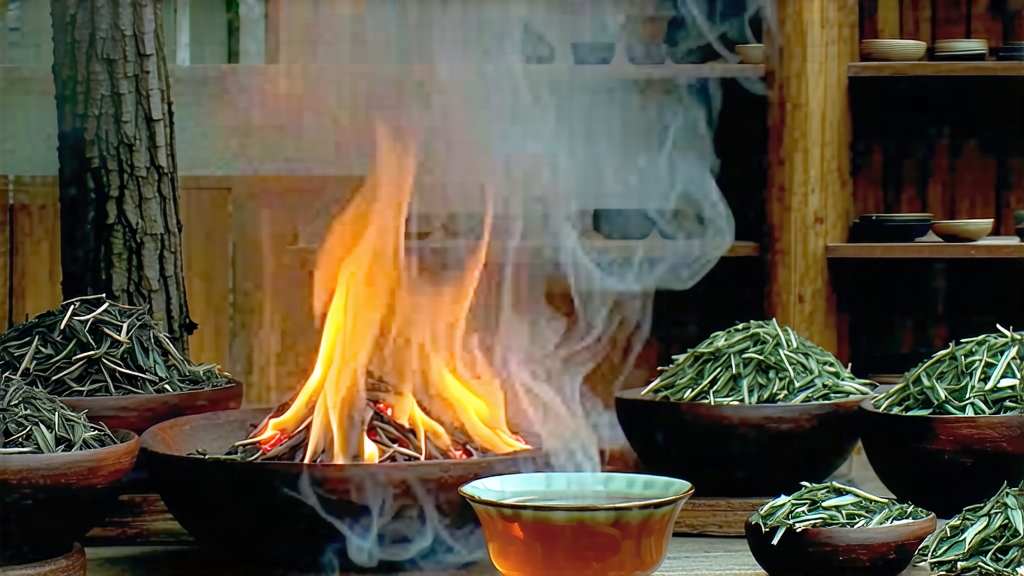
If every family tree has a patriarch, then the sprawling dynasty of black teas scattered across India, Sri Lanka and East Africa can trace its lineage back to one rugged corner of northern Fujian province. There, in the granite folds of the Wuyi Mountains, the village of Tongmu gave the world its first fully oxidised leaf—Lapsang Souchong—during the late Ming dynasty, around 1604. Foreign merchants who reached the port of Xiamen phonetically rendered the local term “Zhengshan Xiaozhong” into “Lapsang Souchong,” and the name stuck, sailing back to Europe in the holds of Dutch vessels that docked in Amsterdam only a year later. By the time Charles II’s Portuguese bride, Catherine of Braganza, popularised tea at the English court in 1662, the pine-smoked aroma of Lapsang had already become the signature scent of the exotic East.
Yet the tea’s origin is less a calculated invention than a serendipitous accident born of war. Legend claims that passing armies commandeered Tongmu’s tea factories during a turbulent season, forcing farmers to rush-dry their leaves over open pine fires so they could finish production before fleeing. The resulting liquor—redder, stronger and laced with campfire sweetness—won instant favour with the Dutch, who paid premiums that forever altered local technique. What began as emergency protocol evolved into deliberate art, and a new category—hong cha, “red tea” in Chinese—was born.
Terroir is the first secret. Tongmu sits in a protected national park where the Min River cuts a misty gorge of 90 % humidity and a diurnal swing of 10 °C. Granite soils poor in nitrogen stress the tea bushes, concentrating aromatic polyphenols, while towering Masson pines shed needles that carpet the ground and perfume the air. Only two cultivars are authorised within the 60 km² core zone: Xiao Ye Zhong (“small-leaf”) and the even rarer Ye Sheng (“wild”). Leaves must be picked before Grain Rain, when the buds still wear a downy cloak and the first two leaves stretch barely 2 cm. One kilogram of finished tea demands 55,000 such shoots, all plucked before 10 a.m. when mountain dew lingers.
Withering begins on bamboo trays set above smouldering pine embers in the upper loft of three-hundred-year-old wooden houses. The goal is not heat but smoke: cool, resinous wisps that drift for 8–10 hours while the leaf loses 60 % moisture and absorbs α-pinene and longifolene, terpenes that later translate into whisky-like notes. Every twenty minutes the master turns the trays by hand, judging readiness by the sound—when a rustle replaces a crackle, the leaf is supple enough to roll.
Rolling follows the ancient “pine board knead”: 8 kg of withered leaf are wrapped in a square of wet cotton and trodden barefoot in a slow dance that lasts 45 minutes. The pressure must be even; too heavy and the leaf macerates, too light and oxidation stalls. When the fabric stains amber and the aroma shifts from cut grass to peach skin, the bundle is untied and the leaf allowed to “rest” for twenty minutes, letting enzymes awaken.
Oxidation is conducted in giant rattan baskets lined with wet cloth. The leaf piles to a depth of 12 cm and is left for 4–5 hours while mountain air, cooled by the river, wafts through slatted windows. Temperature is never allowed above 24 °C; lower oxidation preserves the sweet, malty core that will balance later smoke. Masters test progress by chewing a single leaf: when the bite tastes of dried longan and the veins turn copper-red, the process stops.
Firing is where Tongmu diverges into two distinct styles. Traditional “Smoke-dried” Lapsang is spread on sieves suspended 1.5 m above a pit of pine embers whose temperature hovers at 80 °C. The leaf dries slowly, absorbing resin for 6–8 hours until moisture falls to 4 %. By contrast, the newer “Unsmoked” or “Wuyi Craft” style bypasses direct smoke; instead, the leaf is baked in a charcoal-heated oven lined with bamboo charcoal and fresh pine bark, yielding a subtler, honeyed cup that satisfies modern palates wary of campfire intensity. Both versions are then hand-sorted through